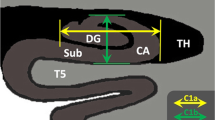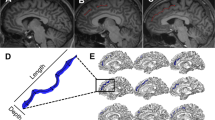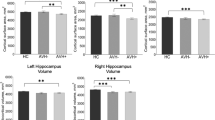Abstract
Hallucinations, and auditory hallucinations (AH) in particular, constitute the most typical and disabling schizophrenia symptoms. Although visual hallucinations (VH) have been largely neglected in psychiatric disorders, a recent review reported a 27% mean prevalence of VH in schizophrenia patients. The pathophysiology underlying VH in schizophrenia remains elusive. Several schizophrenia studies reported a significant effect of age on VH; therefore, we tested the hypothesis that the neurodevelopmental model of schizophrenia may explain VH occurrence. We analyzed cortex sulcation, a marker of brain development, in healthy controls (HCs) and two subgroups of carefully selected schizophrenia patients suffering from hallucinations: patients with only AH (that is, patients who never reported VH) and patients with audio–visual hallucinations (A+VH). Different cortical sulcation and left–right sulcal asymmetry were found between A+VH and AH patients, with decreased sulcation in both A+VH and AH patients in comparison with the HCs. Although a specific association between VH and neurodegenerative mechanisms, for example, in Body-Lewy Dementia or Parkinson’s Disease, has previously been reported in the literature, the current study provides the first neuroimaging evidence of an association between VH and neurodevelopmental mechanisms.
This is a preview of subscription content, access via your institution
Access options
Subscribe to this journal
Receive 12 print issues and online access
$259.00 per year
only $21.58 per issue
Buy this article
- Purchase on Springer Link
- Instant access to full article PDF
Prices may be subject to local taxes which are calculated during checkout


Similar content being viewed by others
References
Jardri R, Cachia A, Thomas P, Pins D . The Neuroscience of Hallucinations. Springer: New-York, USA, 2013.
Andreasen NC, Flaum M . Schizophrenia: the characteristic symptoms. Schizophr Bull 1991; 17: 27–49.
Waters F, Collerton D, Ffytche DH, Jardri R, Pins D, Dudley R et al. Visual hallucinations in the psychosis-spectrum, and comparative information from neurodegenerative disorders and eye disease. Schizophr Bull 2014; 40: S233–S245.
Cummings JL, Miller BL . Visual hallucinations. Clinical occurrence and use in differential diagnosis. West J Med 1987; 146: 46–51.
Bracha HS, Wolkowitz OM, Lohr JB, Karson CN, Bigelow LB . High prevalence of visual hallucinations in research subjects with chronic schizophrenia. Am J Psychiatry 1989; 146: 526–528.
Goodwin DW, Alderson P, Rosenthal R . Clinical significance of hallucinations in psychiatric disorders. A study of 116 hallucinatory patients. Arch Gen Psychiatry 1971; 24: 76–80.
Mueser KT, Bellack AS, Brady EU . Hallucinations in schizophrenia. Acta Psychiatr Scand 1990; 82: 26–29.
Frieske DA, Wilson WP . Formal qualities of hallucinations: a comparative study of the visual hallucinations in patients with schizophrenic, organic, and affective psychoses. Proc Annu Meeting Am Psychopathol Assoc 1966; 54: 49–62.
Allen P, Modinos G, Hubl D, Shields G, Cachia A, Jardri R et al. Neuroimaging auditory hallucinations in schizophrenia: from neuroanatomy to neurochemistry and beyond. Schizophr Bull 2012; 38: 695–703.
Amad A, Cachia A, Gorwood P, Pins D, Delmaire C, Rolland B et al. The multimodal connectivity of the hippocampal complex in auditory and visual hallucinations. Mol Psychiatry 2014; 19: 184–191.
Rapoport JL, Giedd JN, Gogtay N . Neurodevelopmental model of schizophrenia: update 2012. Mol Psychiatry 2012; 17: 1228–1238.
Mangin JF, Jouvent E, Cachia A . In-vivo measurement of cortical morphology: means and meanings. Curr Opin Neurol 2010; 23: 359–367.
Cachia A, Paillere-Martinot ML, Galinowski A, Januel D, de Beaurepaire R, Bellivier F et al. Cortical folding abnormalities in schizophrenia patients with resistant auditory hallucinations. Neuroimage 2008; 39: 927–935.
Hubl D, Dougoud-Chauvin V, Zeller M, Federspiel A, Boesch C, Strik W et al. Structural analysis of Heschl's gyrus in schizophrenia patients with auditory hallucinations. Neuropsychobiology 2010; 61: 1–9.
Plaze M, Paillere-Martinot ML, Penttila J, Januel D, de Beaurepaire R, Bellivier F et al. ‘Where do auditory hallucinations come from?’ A brain morphometry study of schizophrenia patients with inner or outer space hallucinations. Schizophr Bull 2011; 37: 212–221.
Lowe GR . The phenomenology of hallucinations as an aid to differential diagnosis. Br J Psychiatry 1973; 123: 621–633.
Bauer SM, Schanda H, Karakula H, Olajossy-Hilkesberger L, Rudaleviciene P, Okribelashvili N et al. Culture and the prevalence of hallucinations in schizophrenia. Compr Psychiatry 2011; 52: 319–325.
David CN, Greenstein D, Clasen L, Gochman P, Miller R, Tossell JW et al. Childhood onset schizophrenia: high rate of visual hallucinations. J Am Acad Child Adolesc Psychiatry 2011; 50: 681–686, e683.
David C, Rapoport J . A neurodevelopmental perspective on hallucinations. In: Jardri R, Cachia A, Thomas P, Pins D (eds) The Neuroscience of hallucinations. Springer: New-York, USA, pp 203–230 2013.
Kay SR, Fiszbein A, Opler LA . The positive and negative syndrome scale (PANSS) for schizophrenia. Schizophr Bull 1987; 13: 261–276.
Andreasen NC . Methods for assessing positive and negative symptoms. Mod Probl Pharmacopsychiatry 1990; 24: 73–88.
Duchesnay E, Cachia A, Roche A, Riviere D, Cointepas Y, Papadopoulos-Orfanos D et al. Classification based on cortical folding patterns. IEEE Trans Med Imaging 2007; 26: 553–565.
Gardner DM, Murphy AL, O'Donnell H, Centorrino F, Baldessarini RJ . International consensus study of antipsychotic dosing. Am J Psychiatry 2010; 167: 686–693.
Penttila J, Paillere-Martinot ML, Martinot JL, Mangin JF, Burke L, Corrigall R et al. Global and temporal cortical folding in patients with early-onset schizophrenia. J Am Acad Child Adolesc Psychiatry 2008; 47: 1125–1132.
Gay O, Plaze M, Oppenheim C, Mouchet-Mages S, Gaillard R, Olie JP et al. Cortex morphology in first-episode psychosis patients with neurological soft signs. Schizophr Bull 2013; 39: 820–829.
Penttila J, Cachia A, Martinot JL, Ringuenet D, Wessa M, Houenou J et al. Cortical folding difference between patients with early-onset and patients with intermediate-onset bipolar disorder. Bipolar Disord 2009; 11: 361–370.
Penttila J, Paillere-Martinot ML, Martinot JL, Ringuenet D, Wessa M, Houenou J et al. Cortical folding in patients with bipolar disorder or unipolar depression. J Psychiatry Neurosci 2009; 34: 127–135.
Mangin JF, Riviere D, Cachia A, Duchesnay E, Cointepas Y, Papadopoulos-Orfanos D et al. A framework to study the cortical folding patterns. Neuroimage 2004; 23: S129–S138.
Zilles K, Armstrong E, Schleicher A, Kretschmann HJ . The human pattern of gyrification in the cerebral cortex. Anat Embryol (Berl) 1988; 179: 173–179.
Perrot M, Riviere D, Mangin JF . Cortical sulci recognition and spatial normalization. Med Image Anal 2011; 15: 529–550.
Dubois J, Benders M, Borradori-Tolsa C, Cachia A, Lazeyras F, Ha-Vinh Leuchter R et al. Primary cortical folding in the human newborn: an early marker of later functional development. Brain 2008; 131: 2028–2041.
Hilgetag CC, Barbas H . Role of mechanical factors in the morphology of the primate cerebral cortex. PLoS Comput Biol 2006; 2: e22.
Van Essen DC . A tension-based theory of morphogenesis and compact wiring in the central nervous system. Nature 1997; 385: 313–318.
Klyachko VA, Stevens CF . Connectivity optimization and the positioning of cortical areas. Proc Natl Acad Sci USA 2003; 100: 7937–7941.
Rakic P . Specification of cerebral cortical areas. Science 1988; 241: 170–176.
Dehay C, Giroud P, Berland M, Killackey H, Kennedy H . Contribution of thalamic input to the specification of cytoarchitectonic cortical fields in the primate: effects of bilateral enucleation in the fetal monkey on the boundaries, dimensions, and gyrification of striate and extrastriate cortex. J Comp Neurol 1996; 367: 70–89.
Ford JM, Palzes VA, Roach BJ, Potkin SG, van Erp TG, Turner JA et al. Visual hallucinations are associated with hyperconnectivity between the amygdala and visual cortex in people with a diagnosis of schizophrenia. Schizophr Bull, advance online publication, 11 March 2014; doi:10.1093/schbul/sbu031 (e-pub ahead of print).
Geoffroy P, Houenou J, Duhamel A, Amad A, de Weijer A, Curcic-Blake B et al. The Arcuate fasciculus in auditory-verbal hallucinations: a meta-analysis of diffusion-tensor-imaging studies. Schizophrenia Res 2014; 159: 234–237.
Witelson SF . The brain connection: the corpus callosum is larger in left-handers. Science 1985; 229: 665–668.
Putnam MC, Wig GS, Grafton ST, Kelley WM, Gazzaniga MS . Structural organization of the corpus callosum predicts the extent and impact of cortical activity in the nondominant hemisphere. J Neurosci 2008; 28: 2912–2918.
Deary IJ, Penke L, Johnson W . The neuroscience of human intelligence differences. Nat Rev Neurosci 2010; 11: 201–211.
Toga AW, Thompson PM . Mapping brain asymmetry. Nat Rev Neurosci 2003; 4: 37–48.
Crow TJ, Ball J, Bloom SR, Brown R, Bruton CJ, Colter N et al. Schizophrenia as an anomaly of development of cerebral asymmetry. A postmortem study and a proposal concerning the genetic basis of the disease. Arch Gen Psychiatry 1989; 46: 1145–1150.
Crow TJ . Is schizophrenia the price that Homo sapiens pays for language?. Schizophr Res 1997; 28: 127–141.
Dubois J, Hertz-Pannier L, Cachia A, Mangin JF, Le Bihan D, Dehaene-Lambertz G . Structural asymmetries in the infant language and sensori-motor networks. Cereb Cortex 2008; 19: 414–423.
Leroy F, Glasel H, Dubois J, Hertz-Pannier L, Thirion B, Mangin JF et al. Early maturation of the linguistic dorsal pathway in human infants. J Neurosci 2011; 31: 1500–1506.
Corballis PM . Visuospatial processing and the right-hemisphere interpreter. Brain Cogn 2003; 53: 171–176.
Jonas J, Frismand S, Vignal JP, Colnat-Coulbois S, Koessler L, Vespignani H et al. Right hemispheric dominance of visual phenomena evoked by intracerebral stimulation of the human visual cortex. Hum Brain Mapp 2014; 35: 3360–3371.
Bombin I, Arango C, Buchanan RW . Significance and meaning of neurological signs in schizophrenia: two decades later. Schizophr Bull 2005; 31: 962–977.
Peralta V, de Jalon EG, Campos MS, Basterra V, Sanchez-Torres A, Cuesta MJ . Risk factors, pre-morbid functioning and episode correlates of neurological soft signs in drug-naive patients with schizophrenia-spectrum disorders. Psychol Med 2010; 41: 1279–1289.
Biswas P, Malhotra S, Malhotra A, Gupta N . Comparative study of neurological soft signs in schizophrenia with onset in childhood, adolescence and adulthood. Acta Psychiatr Scand 2007; 115: 295–303.
Vourdas A, Pipe R, Corrigall R, Frangou S . Increased developmental deviance and premorbid dysfunction in early onset schizophrenia. Schizophr Res 2003; 62: 13–22.
Whitfield-Gabrieli S, Thermenos HW, Milanovic S, Tsuang MT, Faraone SV, McCarley RW et al. Hyperactivity and hyperconnectivity of the default network in schizophrenia and in first-degree relatives of persons with schizophrenia. Proc Natl Acad Sci USA 2009; 106: 1279–1284.
Clos M, Diederen KM, Meijering AL, Sommer IE, Eickhoff SB . Aberrant connectivity of areas for decoding degraded speech in patients with auditory verbal hallucinations. Brain Struct Funct 2014; 219: 581–594.
Sommer IE, Clos M, Meijering AL, Diederen KM, Eickhoff SB . Resting state functional connectivity in patients with chronic hallucinations. PLoS ONE 2012; 7: e43516.
Wolf ND, Sambataro F, Vasic N, Frasch K, Schmid M, Schonfeldt-Lecuona C et al. Dysconnectivity of multiple resting-state networks in patients with schizophrenia who have persistent auditory verbal hallucinations. J Psychiatry Neurosci 2011; 36: 366–374.
Jardri R, Thomas P, Delmaire C, Delion P, Pins D . The neurodynamic organization of modality-dependent hallucinations. Cereb Cortex 2013; 23: 1108–1117.
Shine JM, Halliday GM, Naismith SL, Lewis SJ . Visual misperceptions and hallucinations in Parkinson's disease: dysfunction of attentional control networks?. Mov Disord 2011; 26: 2154–2159.
Ono M, Kubik S, Abarnathey CD . Atlas of the Cerebral Sulci. Georg Thieme: New York, 1990.
Cachia A, Mangin JF, Riviere D, Papadopoulos-Orfanos D, Kherif F, Bloch I et al. A generic framework for the parcellation of the cortical surface into gyri using geodesic Voronoi diagrams. Med Image Anal 2003; 7: 403–416.
Giedd JN, Rapoport JL . Structural MRI of pediatric brain development: what have we learned and where are we going?. Neuron 2010; 67: 728–734.
Ramanan VK, Shen L, Moore JH, Saykin AJ . Pathway analysis of genomic data: concepts, methods, and prospects for future development. Trends Genet 2012; 28: 323–332.
Acknowledgements
This study was supported by the GDR CNRS—3557 ‘Institut de Recherche en Psychiatrie’ as well as by grants from the ERANET-NEURON program (AUSZ_EUCan), the Programme Hospitalier de Recherche Clinique (PHRC Multimodhal), the Pierre Houriez foundation (hosted by the Fondation de France), the Pierre Deniker foundation and the NRJ foundation.
Author Contributions
All the authors designed the study; AA, PT, JB, RJ recruited the participants; JB & RJ acquired the MRI data; AC, AA, RJ performed the analyses; All the authors contributed to the manuscript writing.
Author information
Authors and Affiliations
Corresponding author
Ethics declarations
Competing interests
The authors declare no conflict of interest.
PowerPoint slides
Rights and permissions
About this article
Cite this article
Cachia, A., Amad, A., Brunelin, J. et al. Deviations in cortex sulcation associated with visual hallucinations in schizophrenia. Mol Psychiatry 20, 1101–1107 (2015). https://doi.org/10.1038/mp.2014.140
Received:
Revised:
Accepted:
Published:
Issue Date:
DOI: https://doi.org/10.1038/mp.2014.140
This article is cited by
-
Hearing voices as a feature of typical and psychopathological experience
Nature Reviews Psychology (2022)
-
Cognitive insights from tertiary sulci in prefrontal cortex
Nature Communications (2021)
-
Deviations in early hippocampus development contribute to visual hallucinations in schizophrenia
Translational Psychiatry (2020)
-
Evidence in cortical folding patterns for prenatal predispositions to hallucinations in schizophrenia
Translational Psychiatry (2020)
-
The value of doing philosophy in mental health contexts
Medicine, Health Care and Philosophy (2020)



